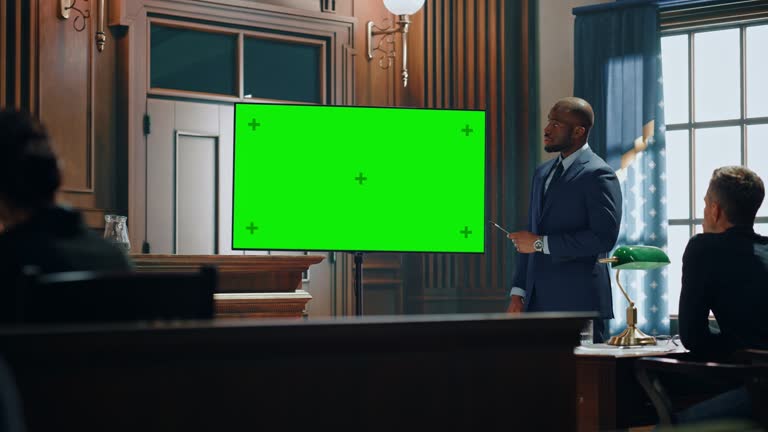Essential Abilities for Crafting Influential Trial Presentations: A Comprehensive Overview
Essential Abilities for Crafting Influential Trial Presentations: A Comprehensive Overview
Blog Article
Browsing the Complexities of Test Presentations: Tips for Seamless Distribution and Compelling Disagreements
In the realm of legal procedures, the art of trial discussion stands as a critical factor of success. The intricacies fundamental in test presentations require a fragile equilibrium of technique, ability, and finesse.

Understanding Trial Purposes
To successfully navigate a trial, it is vital to have a clear understanding of the purposes that require to be accomplished. Prior to stepping into the court room, lawful groups must define their goals and desired end results. These purposes function as directing concepts throughout the trial, forming approaches and affecting decision-making procedures.
Recognizing trial purposes involves a thorough analysis of the case, lawful precedents, and the customer's ideal interests. Trial Presentations. It needs a thorough examination of the truths, determining crucial issues, and preparing for possible obstacles. By setting particular and quantifiable objectives, attorneys can customize their presentations and arguments to straighten with the preferred outcomes
In addition, a clear understanding of trial goals allows lawful groups to focus on evidence, witnesses, and lawful disagreements successfully. It permits the growth of a systematic narrative that resonates with the discretionary, reinforcing the total instance discussion.

Organizing Evidence Effectively
Having a clear understanding of test goals lays the structure for organizing evidence effectively in lawful procedures - Trial Presentations. By lining up the discussion of proof with the preferred outcomes of the trial, lawful groups can reinforce their arguments and boost their persuasiveness. One crucial aspect of organizing evidence is classification. Organizing proof based upon motifs or importance to details legal components can help improve the discussion and make complicated information more absorbable for the court or court.
One more key aspect in organizing proof properly is developing a logical flow. Presenting proof in a sequential and systematic manner can aid construct an engaging story that supports the lawful arguments being made. Additionally, making use of visual help such as timelines, charts, or charts can even more enhance the company of evidence and aid in clarifying complicated connections or series of occasions.
Furthermore, making certain that all evidence offered is relevant and permissible to the instance is important. Inadmissible or irrelevant evidence can detract from the strength of the disagreement and potentially harm the trustworthiness of today event. A careful testimonial and selection procedure should be taken on to consist of only the most impactful and legally sound proof in the test discussion.
Crafting Convincing Narratives
Crafting compelling narratives plays a pivotal role in offering persuasive arguments during legal process. When building a narrative for a test presentation, image source it is important to establish a clear story that highlights essential points and links them in a meaningful manner. By weaving with each other evidence, statement, and lawful disagreements right into a influential and cohesive narrative, legal specialists can have a peek here effectively promote for their customers and boost the chance of a desirable end result in the court.
Mastering Visual Help
Efficient use of visual aids is key to enhancing the effect and clarity of trial presentations. Aesthetic help, when made use of tactically, have the power to streamline complicated information, strengthen vital points, and leave a long-term impression on the judge and jury. To understand aesthetic aids in test discussions, it is crucial to make certain that they are clear, succinct, and appropriate to the debates being made.
When integrating aesthetic aids, such as charts, graphs, timelines, or pictures, right into a test discussion, it is necessary to maintain them visually appealing yet specialist. The visuals should match the spoken arguments, offering a graph of the details being talked about without overwhelming the target market with unneeded information.
Moreover, experimenting the aesthetic help ahead of time is important to make certain a seamless delivery during the trial. Familiarizing oneself with the material, changes, and timings of each aesthetic help can aid maintain the flow of the discussion and avoid technological problems that may arise.
Providing Impactful Closing Debates
An engaging closing disagreement offers as the end result of a test presentation, encapsulating the core story and persuading the judge and jury towards a desirable decision. Begin by describing the major debates that sustain your client's setting, highlighting why the evidence offered throughout the trial sustains your narrative.
Additionally, including emotional appeal can even more enhance your closing disagreement. reference Ultimately, a well-crafted closing debate ought to leave a long lasting impression, engaging the judge and jury to rule in your client's support.
Conclusion
In conclusion, mastering test presentations includes recognizing purposes, organizing evidence, crafting stories, utilizing aesthetic aids, and supplying impactful closing disagreements. By applying these approaches effectively, legal representatives can provide their case effortlessly and make compelling debates in the courtroom. It is essential to navigate the intricacies of trial discussions with precision and ability to achieve success in lawful proceedings.
By lining up the discussion of evidence with the preferred results of the test, lawful teams can reinforce their arguments and boost their persuasiveness (Trial Presentations). To grasp aesthetic help in test discussions, it is important to guarantee that they are clear, succinct, and pertinent to the debates being made
An engaging closing argument serves as the conclusion of a test discussion, enveloping the core narrative and encouraging the court and court towards a beneficial decision. Begin by laying out the main debates that support your customer's placement, emphasizing why the evidence offered throughout the trial sustains your story.In verdict, grasping test discussions includes recognizing objectives, organizing proof, crafting stories, making use of aesthetic aids, and supplying impactful closing arguments.
Report this page